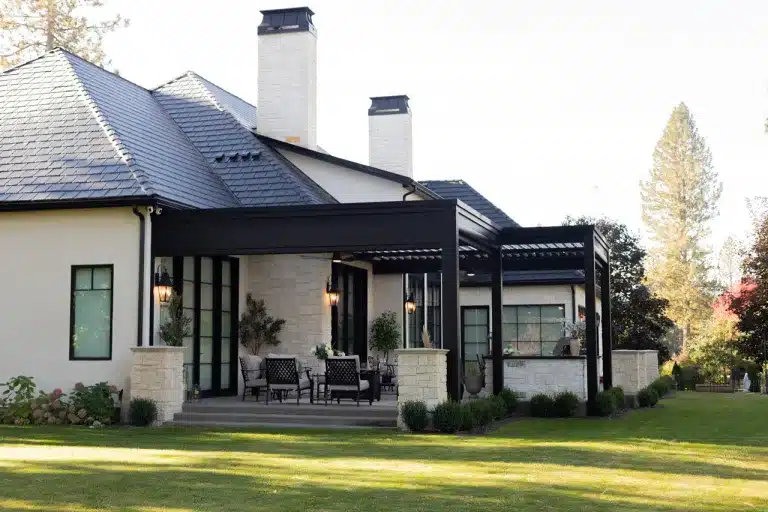An attached pergola can truly enhance the way your family enjoys time outdoors, but only when it’s done right. It can also increase the value of your home. Let’s dive into the essentials so you know exactly what to expect before getting started.
Attaching a pergola to your house is one of the most effective ways to create a seamless connection between indoor comfort and outdoor living. Whether for entertaining guests or relaxing after a long day, attached pergolas combine structure, style, and shade in one smart design.
At Azenco Outdoor, we’ve seen how the right pergola can completely change how people use their patios and backyards. Still, attaching a pergola is not a decision to take lightly; it involves planning, safety considerations, and an understanding of how the structure will connect to your home.
This guide walks you through every essential detail, from anchoring hardware and installation methods to safety standards and design inspiration, so you can make confident, informed choices.
Table of Contents
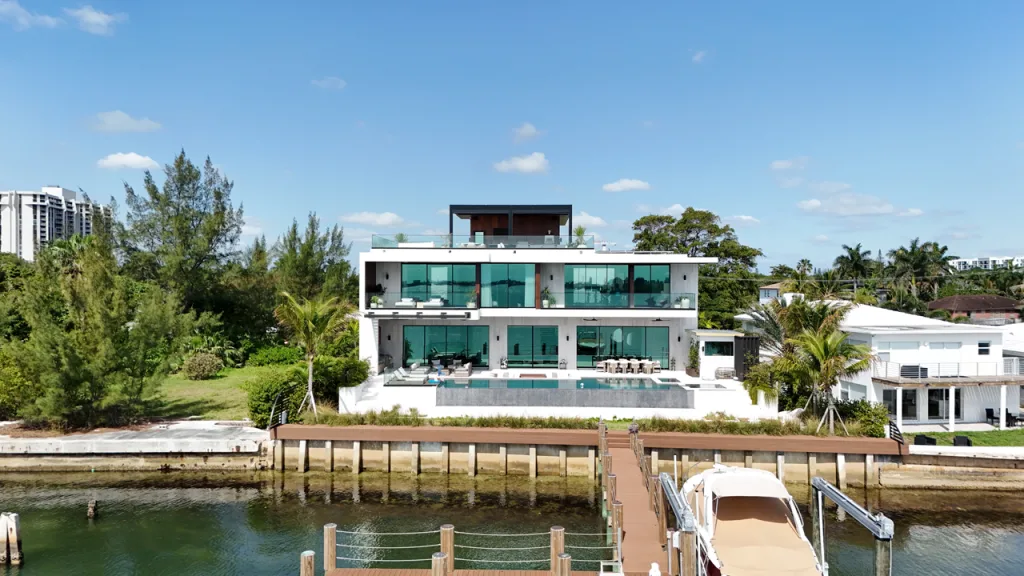

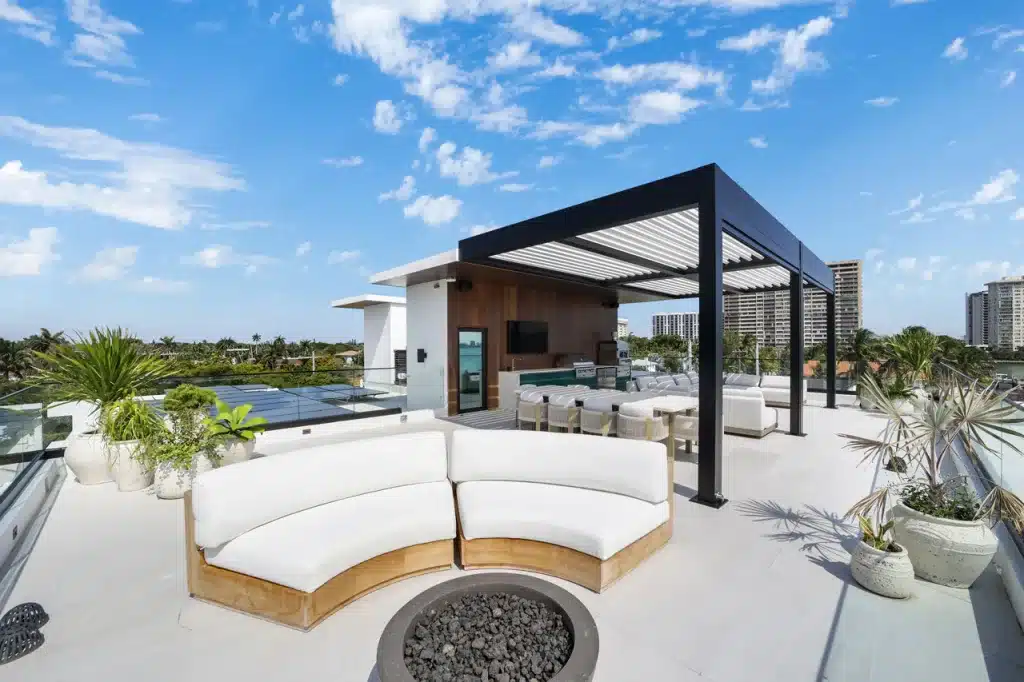

Anchoring Hardware for Attached Pergolas
When attaching a pergola to your home, the anchoring hardware determines how strong and long-lasting the structure will be. Every connection point plays a role in keeping your pergola stable and aligned with your house.
From years of experience in outdoor construction, Azenco Outdoor recommends using the correct combination of materials to match your wall type and climate. The three most common hardware options include:
- Carriage bolts: Perfect for solid connections through ledger boards, providing exceptional strength for large spans.
- Lag screws: Ideal when attaching to wood framing; these heavy-duty fasteners can handle significant weight without loosening over time.
- Tapcons: Made for concrete or masonry walls, these screws offer secure, long-term anchoring without cracking the surface
Each of these ensures even weight distribution and prevents unwanted movement.
Our own pergola systems use concealed fasteners and corrosion-resistant materials, creating a clean, modern look while ensuring durability. Homeowners appreciate how this subtle design keeps the focus on the pergola’s architectural lines, not the hardware holding it up.

Installation Methods for Attaching a Pergola
When it comes to pergola installation, the process varies depending on the material and structure type. The two most common approaches are for wooden pergolas and aluminum pergolas.
Wooden Pergolas
Wooden pergolas require a ledger board that spreads the structure’s weight evenly across the home’s surface. Between the ledger and house siding, metal flashing must be installed to prevent water from seeping into the wall. Without this barrier, moisture can lead to rot or mold inside the wall cavity.
Because wood expands and contracts, precise installation is critical. Every cut, screw, and flashing piece must fit perfectly to ensure the pergola is secure.
Aluminum Pergolas
Aluminum systems, like Azenco Outdoor’s motorized aluminum pergolas or fixed louvered pergolas, allow for direct attachment to a header board or rim joist. These structures are engineered for precision alignment and designed to complement the home’s existing architecture.
Unlike wood, aluminum doesn’t warp or crack, which means clean lines and low maintenance for years to come.
Professional installation is always recommended. Expert crews ensure that each connection point is properly sealed, level, and code-compliant, giving homeowners confidence that the structure will perform safely under all conditions.
Thinking about upgrading your outdoor space?
Our brochure is packed with inspiration, design options, and key details to help you make the right choice.
Safety and Compliance
Because an attached pergola functions as an extension of your home, compliance with building codes is essential. Pergolas may look simple, but they’re technically complex outdoor structures that must handle significant wind, snow, and rain loads.
Before starting the project, homeowners should confirm the following:
- Building permits: Most regions require approval before installation.
- Structural load ratings: The pergola must meet wind and snow standards for your area.
- Engineering certification: Systems should be rated and tested for long-term durability.
At Azenco Outdoor, all pergola models are engineered and load-rated to meet or exceed regional standards. Our motorized aluminum pergola carries Miami-Dade NOA certification, one of the most rigorous testing standards in the country.
This ensures that every pergola we produce isn’t just beautiful, but built to last through hurricanes, heavy rain, and harsh sunlight. Safety and structural integrity come first, giving homeowners complete peace of mind.
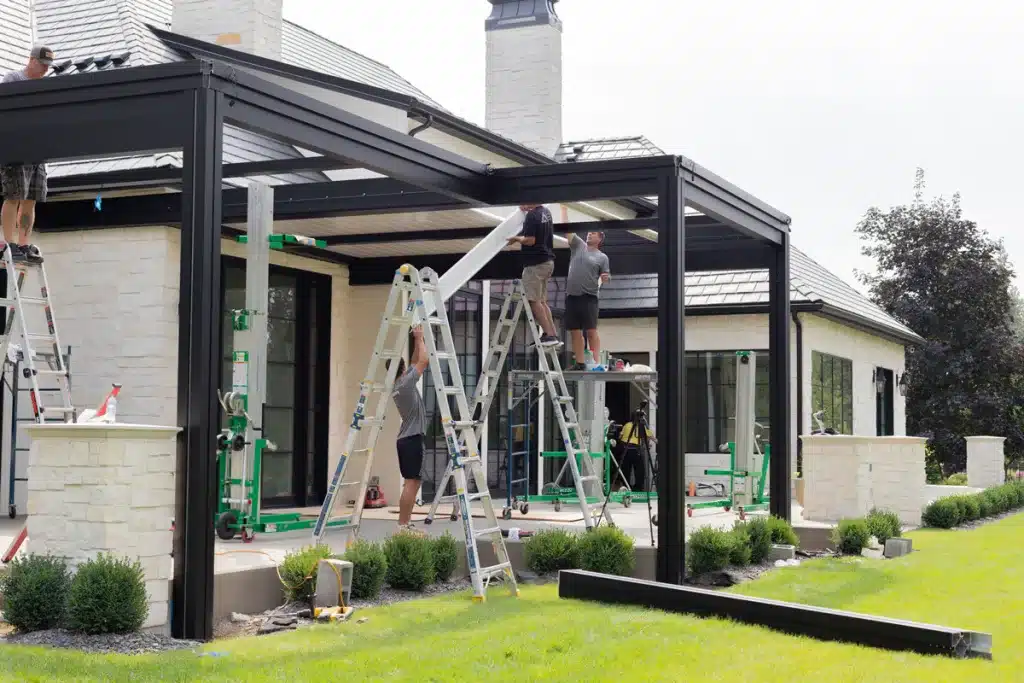
Gutter Scenarios When Attaching a Pergola
One of the most common challenges when attaching a pergola to a house involves existing gutters. Many homeowners ask: Can I attach a pergola if I already have gutters? The answer is yes, but the approach depends on the setup.
1. Riser Brackets
Riser brackets mount either above or below the fascia board, supporting the pergola beam. While this option can be cost-effective, it’s less visually appealing and carries the risk of roof penetration, which may cause leaks over time.
2. Structural Gutter System
The more refined solution is a Azenco Outdoor structural gutter, sometimes called a “super gutter.” This method replaces the home’s existing gutter with a load-bearing aluminum system strong enough to support the pergola’s structure. It keeps your roof drainage separate from the pergola’s built-in water channels, avoiding overflow or damage.
A structural gutter system is not only more durable but also achieves a cleaner, integrated appearance. Water flows smoothly through concealed channels, and your home’s roofline stays intact. This design reflects Azenco Outdoor’s signature attention to detail, balancing engineering precision with refined aesthetics.
Alternative Solution – Freestanding Pergolas
For some homes, attaching a pergola directly to the wall isn’t an option. The wall might not be load-bearing, or the homeowner may prefer to avoid drilling into their home’s structure. In those cases, a freestanding pergola provides the ideal solution.
Freestanding pergolas can stand just a few inches away from the wall, creating the same sense of architectural connection without physical attachment. This approach also provides flexibility for patios, decks, and pool areas where alignment or spacing is limited.
Azenco Outdoor offers several freestanding designs, including the manual louvered pergola, known for its versatility and modular design. Homeowners can also choose from two different standard sizes, add floors, and select finishes that match their home’s style.
Our adjustable roof pergolas and patio covers can also function as freestanding structures. This gives you the freedom to create shade exactly where you need it while maintaining a cohesive, high-end look.
The Value of an Attached Pergola
An attached pergola is more than a shade structure; it’s an architectural investment that enhances daily living.
From our experience working on hundreds of projects, the most common homeowner feedback is that an attached pergola changes how they use their space. It creates a natural transition between the indoors and outdoors, encouraging more time outside while protecting from direct sunlight and rain.
Thinking about upgrading your outdoor space?
Our brochure is packed with inspiration, design options, and key details to help you make the right choice.
Here are a few key benefits homeowners often mention:
- Continuous shade that keeps interior rooms cooler.
- Expanded outdoor space perfect for dining or entertaining.
- Improved aesthetics through architectural balance.
- Increased property value and market appeal.
An attached pergola feels like a natural continuation of your home, blending comfort with functionality. Over time, it delivers not only enjoyment but measurable returns on investment.
With designs like our motorized outdoor roofs and automated pergolas, you can adjust sunlight and ventilation with a simple touch or voice command. This adaptability makes the system both luxurious and practical—bringing innovation to the heart of outdoor living.

Design Inspiration
Designing an attached pergola allows you to express creativity while complementing your home’s style. Whether your space leans modern, coastal, or traditional, there’s an Azenco Outdoor solution for every aesthetic.
Here are a few popular attached pergola ideas:
- Modern minimalist: Choose a black or charcoal motorized louvered pergola with accessory beams.
- Coastal charm: Select a white frame with woodgrain finishes that reflect natural textures and pair beautifully with light, airy furniture.
- Contemporary comfort: Add integrated LED lighting, heating, and fans for year-round use.
Our luxury pergolas are designed to merge functionality with refined style. With options like smart pergola systems, homeowners can control louvers, screens, and lighting through smart devices or voice assistants.
Imagine quiet mornings under soft, filtered light or evenings spent entertaining as the louvers tilt automatically to the perfect angle. With Azenco Outdoor’s precision engineering and modern pergola design, outdoor living becomes effortless and elegant.
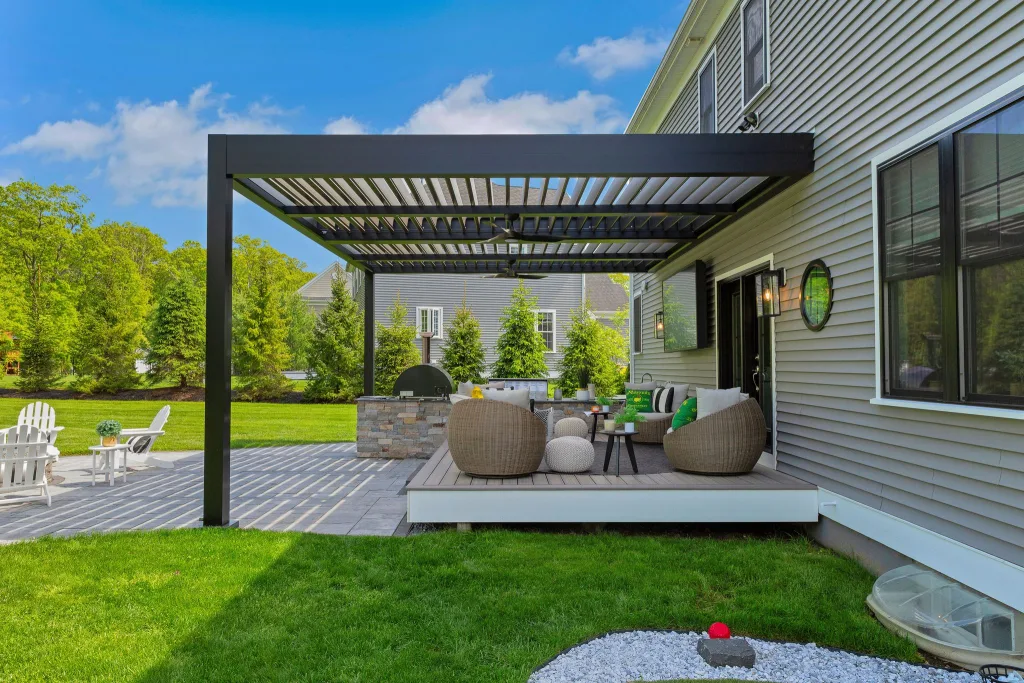

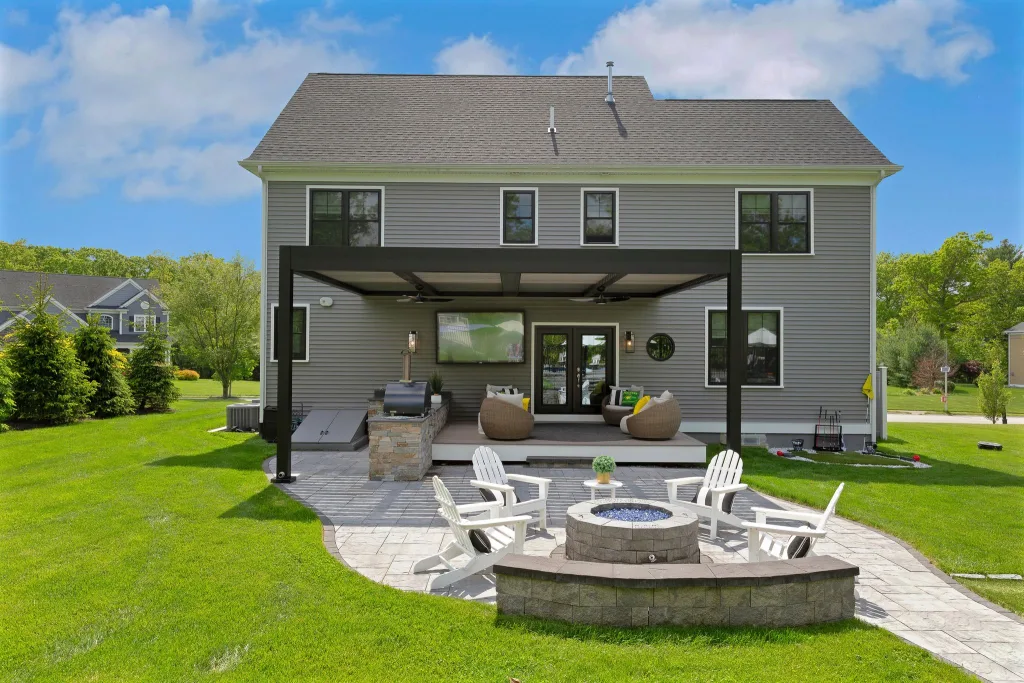
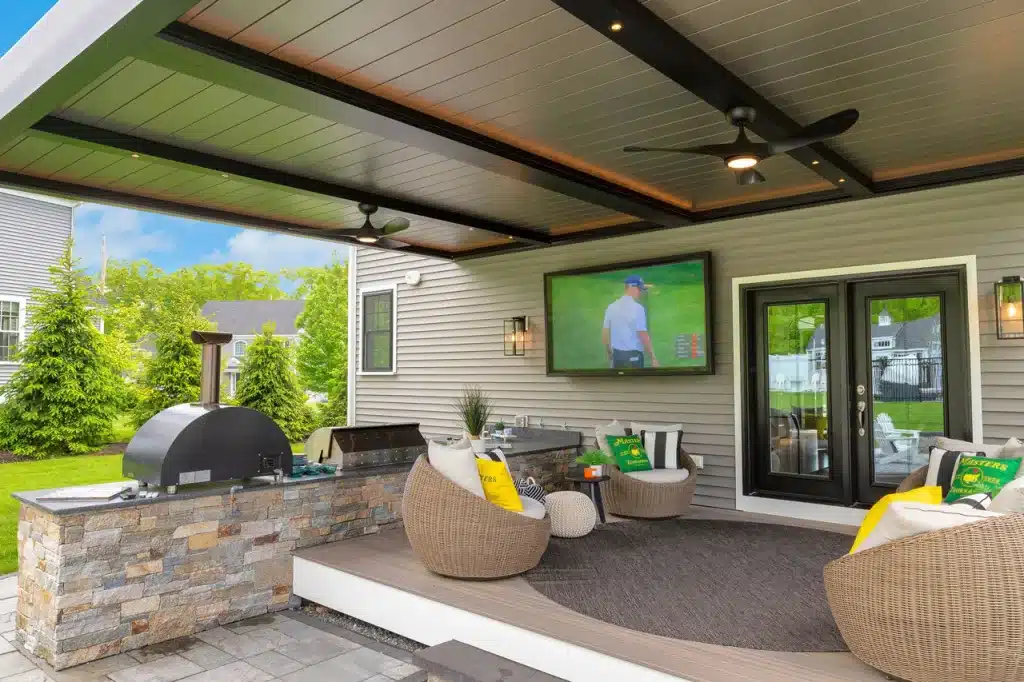
Ready to bring your outdoor vision to life?
Tell us about your project, and our certified local dealer will provide a tailored quote with the best options—no commitment, just expert guidance.
Final Thoughts
Attaching a pergola to your house is a great way to expand your living space and enjoy the outdoors year-round. With the right installation, it adds beauty, comfort, and long-term value.
At Azenco Outdoor, every project reflects years of expertise, thoughtful design, and precision engineering. Whether you’re planning an attached or freestanding pergola, our team will help you find the ideal solution for your home and lifestyle.
With innovation, quality, and timeless design, Azenco Outdoor continues to redefine modern outdoor living.
Frequently Asked Questions
Can I attach a pergola to any house type?
In most cases, yes, but it depends on your home’s wall structure. Masonry, concrete, and framed walls can usually support attachment with proper anchoring hardware.
Do I need a permit to attach a pergola?
Yes. Because an attached pergola is considered a structural addition, local building permits are almost always required before installation begins.
What’s the difference between an attached and freestanding pergola?
An attached pergola connects directly to your home for a seamless look, while a freestanding pergola stands independently. Both offer similar shade and comfort benefits.
Can I install an attached pergola myself?
It’s not recommended. Professional installation ensures that the pergola meets local codes, handles weight correctly, and integrates safely with your home’s design.
Will an attached pergola increase my home’s value?
Absolutely. Homeowners often find that adding an attached pergola improves curb appeal and overall property value while enhancing daily living experiences.

Leslie Chapus
Vice President & Co-Founder
Leslie oversees sales and marketing at Azenco Outdoor, with a focus on modern outdoor living solutions.

